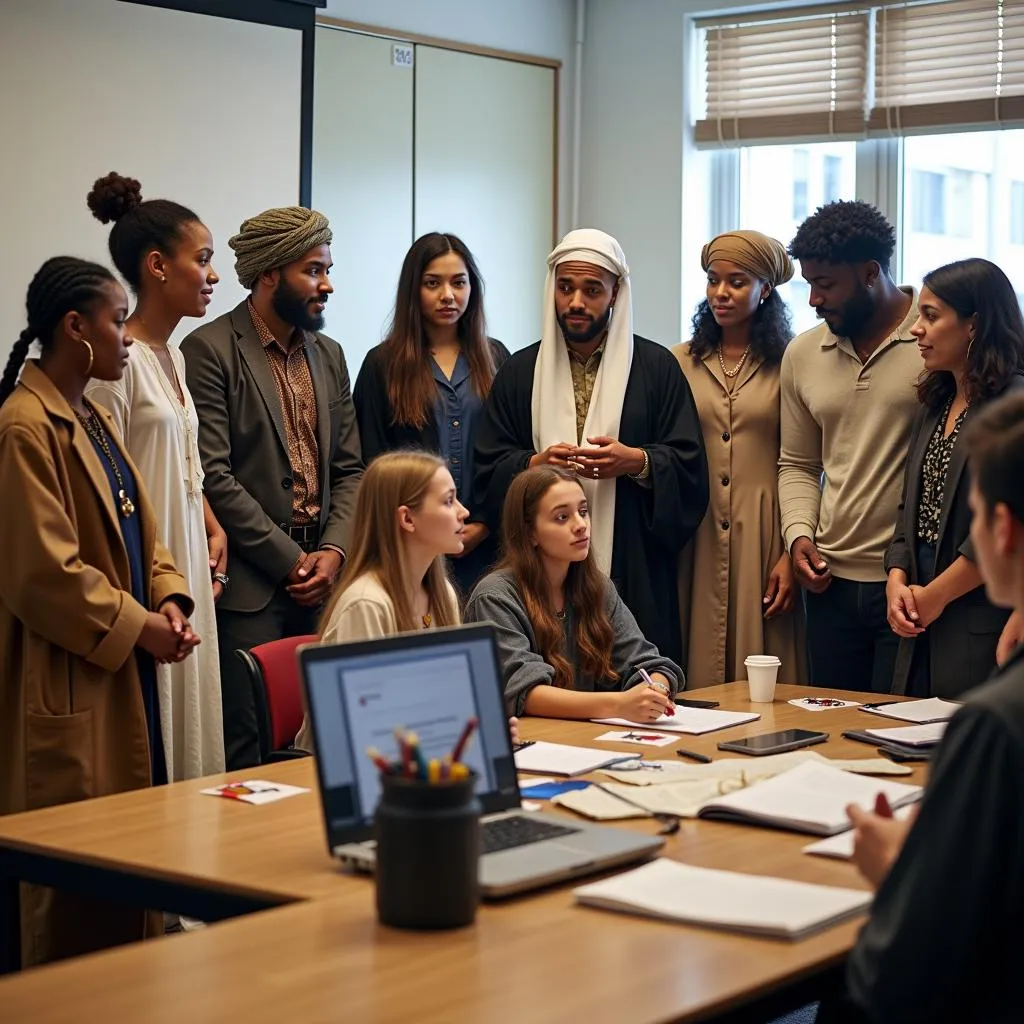IELTS Reading Practice Test
Passage 1 – Easy Text
Cultural sensitivity has become increasingly important in the field of global history education. As our world becomes more interconnected, educators must adapt their teaching methods to accommodate diverse perspectives and experiences. This approach not only enhances students’ understanding of historical events but also promotes empathy and cultural awareness.
Nội dung bài viết
One key aspect of culturally sensitive teaching is the inclusion of multiple narratives. Rather than presenting history from a single viewpoint, educators should strive to incorporate various cultural perspectives. This approach helps students recognize that historical events can be interpreted differently depending on one’s cultural background and experiences.
Another crucial element is the use of diverse resources. Textbooks, primary sources, and multimedia materials should represent a wide range of cultures and viewpoints. By exposing students to diverse materials, teachers can help them develop a more nuanced understanding of global history and challenge their own biases.
Educators must also be mindful of their language and terminology when discussing different cultures and historical events. Using respectful and inclusive language helps create a safe learning environment where all students feel valued and represented.
 Cultural sensitivity in global history classroom
Cultural sensitivity in global history classroom
Questions 1-5
Do the following statements agree with the information given in the reading passage?
Write:
TRUE if the statement agrees with the information
FALSE if the statement contradicts the information
NOT GIVEN if there is no information on this
- Cultural sensitivity is becoming less important in global history education.
- Including multiple narratives helps students understand different interpretations of historical events.
- Textbooks should only represent the dominant culture’s perspective.
- Teachers should use respectful and inclusive language when discussing different cultures.
- Cultural sensitivity in education leads to improved academic performance.
Passage 2 – Medium Text
The implementation of culturally sensitive approaches in teaching global history requires a multifaceted strategy. Educators must not only revise their curriculum but also adapt their pedagogical methods to create an inclusive learning environment. This process involves continuous self-reflection and professional development to address inherent biases and expand cultural knowledge.
One effective technique is the use of comparative historical analysis. By examining similar events or phenomena across different cultures and time periods, students can identify both universal patterns and unique cultural contexts. This approach fosters critical thinking skills and helps students appreciate the complexity of global historical narratives.
Another important aspect is the integration of local histories into the broader global context. By connecting local events and figures to larger historical movements, students can better understand the interconnectedness of global history and their own place within it. This approach also helps to validate the experiences and histories of diverse student populations.
The use of technology and digital resources can greatly enhance culturally sensitive teaching. Virtual field trips, online collaborations with international classrooms, and digital archives provide students with immersive experiences and access to primary sources from various cultures. These tools can help bridge geographical and cultural gaps, offering students a more comprehensive view of global history.
 Comparative historical analysis in the classroom
Comparative historical analysis in the classroom
Educators must also be mindful of the potential for cultural appropriation in their teaching methods. While it’s important to incorporate diverse cultural elements, care must be taken to present these elements respectfully and in proper context. This requires ongoing dialogue with students and community members from various cultural backgrounds to ensure authentic representation.
Lastly, assessment methods should be designed to reflect culturally sensitive teaching practices. Traditional exams may not always be the most appropriate way to evaluate understanding in a multicultural context. Project-based assessments, oral presentations, and collaborative assignments can provide more inclusive ways for students to demonstrate their knowledge and skills.
Questions 6-10
Choose the correct letter, A, B, C, or D.
-
According to the passage, culturally sensitive teaching in global history requires:
A) Only curriculum revision
B) Only adapting pedagogical methods
C) Both curriculum revision and adapting pedagogical methods
D) Neither curriculum revision nor adapting pedagogical methods -
Comparative historical analysis helps students to:
A) Focus solely on universal patterns
B) Ignore cultural contexts
C) Identify both universal patterns and unique cultural contexts
D) Simplify complex historical narratives -
Integrating local histories into the global context:
A) Is not important for understanding global history
B) Helps students understand the interconnectedness of global history
C) Should be avoided to maintain objectivity
D) Is only relevant for minority students -
The use of technology in culturally sensitive teaching:
A) Is not recommended
B) Can only be used for virtual field trips
C) Can help bridge geographical and cultural gaps
D) Is too expensive to implement -
When incorporating diverse cultural elements, teachers should:
A) Avoid them altogether to prevent cultural appropriation
B) Use them without considering their context
C) Present them respectfully and in proper context
D) Only use elements from the dominant culture
Passage 3 – Hard Text
The paradigm shift towards cultural sensitivity in teaching global history necessitates a profound reevaluation of historiographical methodologies and epistemological frameworks. This transformation challenges the long-standing Eurocentric narrative that has dominated historical discourse and pedagogy for centuries. The deconstruction of this hegemonic perspective requires a nuanced understanding of the intersectionality of cultural, social, and political factors that shape historical interpretation.
One of the most significant challenges in implementing culturally sensitive approaches is the reconciliation of conflicting narratives. Historical events, particularly those involving cross-cultural interactions or conflicts, often have multiple, sometimes contradictory, interpretations. Educators must navigate these complexities, encouraging students to critically analyze various viewpoints while avoiding the pitfall of historical relativism.
The concept of historical empathy plays a crucial role in this context. It involves not only understanding the actions and motivations of historical figures within their cultural and temporal context but also recognizing the limitations of our own cultural lens when interpreting the past. This approach requires a delicate balance between cultural relativism and universal ethical standards, particularly when addressing controversial historical issues such as colonialism, slavery, or genocide.
 Historical empathy in a diverse classroom
Historical empathy in a diverse classroom
The digitalization of historical archives and the democratization of access to primary sources have revolutionized the teaching of global history. However, this abundance of information presents new challenges. Educators must develop students’ digital literacy and critical evaluation skills to navigate the vast sea of online resources, distinguishing between credible sources and misinformation. Moreover, the digital divide and language barriers can perpetuate inequalities in access to historical knowledge, requiring innovative solutions to ensure inclusive education.
The decolonization of historical knowledge is an ongoing process that extends beyond the classroom. It involves challenging the power structures that have traditionally determined which histories are told and how they are presented. This process requires collaboration between educators, historians, and communities to uncover and integrate subaltern narratives that have been marginalized or erased from mainstream historical accounts.
Lastly, the implementation of culturally sensitive approaches in teaching global history must be seen as part of a broader effort towards global citizenship education. By fostering intercultural understanding and critical engagement with diverse historical perspectives, educators can prepare students to navigate the complexities of our interconnected world, promoting empathy, social justice, and sustainable development.
Questions 11-14
Complete the summary below.
Choose NO MORE THAN TWO WORDS from the passage for each answer.
Cultural sensitivity in teaching global history involves challenging the traditional (11) __ narrative that has dominated historical discourse. This approach requires understanding the (12) __ of various factors that influence historical interpretation. One major challenge is the (13) __ of different versions of historical events. Educators must encourage students to analyze multiple viewpoints while avoiding (14) __.
Questions 15-20
Complete the sentences below.
Choose NO MORE THAN THREE WORDS from the passage for each answer.
-
The concept of __ involves understanding historical figures within their cultural context while recognizing our own biases.
-
The __ and increased access to primary sources have changed how global history is taught.
-
Students need to develop __ to evaluate online historical resources effectively.
-
The process of __ involves challenging traditional power structures in historical narratives.
-
Integrating __ that have been marginalized is part of decolonizing historical knowledge.
-
Culturally sensitive teaching in global history contributes to __, preparing students for an interconnected world.
Answer Key
Passage 1 (Questions 1-5)
- FALSE
- TRUE
- FALSE
- TRUE
- NOT GIVEN
Passage 2 (Questions 6-10)
- C
- C
- B
- C
- C
Passage 3 (Questions 11-20)
- Eurocentric
- intersectionality
- reconciliation
- historical relativism
- historical empathy
- digitalization of historical archives
- digital literacy
- decolonization of historical knowledge
- subaltern narratives
- global citizenship education
This IELTS Reading practice test focuses on the theme of cultural sensitivity in teaching global history, aligning with the key concepts discussed in related articles about cultural sensitivity in inclusive curricula development and cultural representation in global education curricula. The passages progressively increase in difficulty, mirroring the structure of an actual IELTS Reading test.
The first passage introduces the basic concepts of cultural sensitivity in history education, similar to how schools foster cultural inclusion. The second passage delves deeper into implementation strategies, touching on the use of technology and local histories, which relates to how museums support cultural education for young learners. The third passage explores more complex ideas such as historiographical methodologies and the decolonization of historical knowledge, reflecting on how globalization is reshaping traditional arts education.
By practicing with this test, IELTS candidates can improve their reading comprehension skills while gaining valuable insights into the importance of cultural sensitivity in global education.


